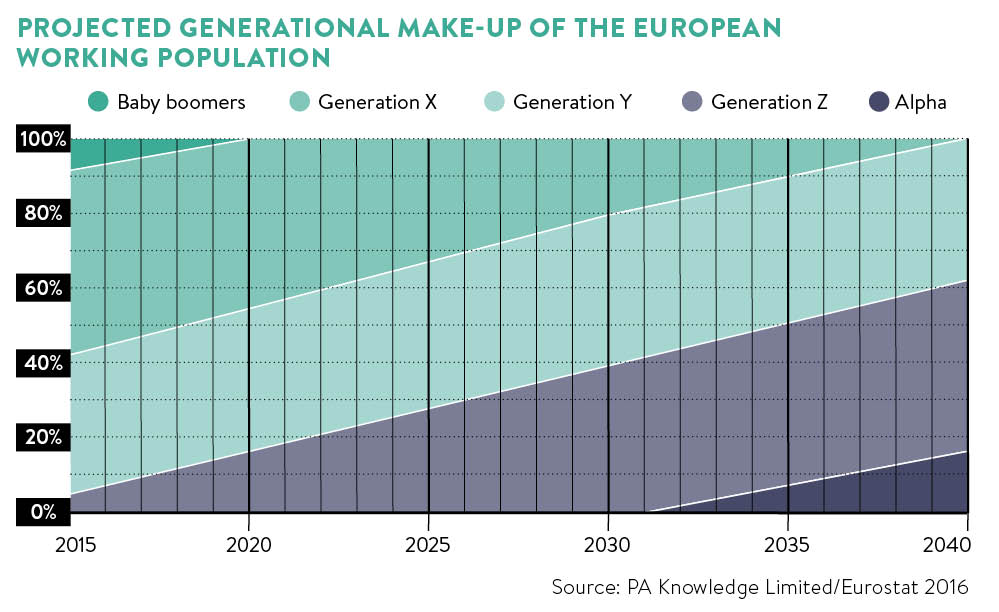For most bosses, letting 15-year-old schoolchildren roam around the office isn’t exactly high on their list of priorities. At video-conferencing firm Fuze though, the benefits are seen as so significant, the company cannot understand why others aren’t doing the same. Why? “This isn’t about what youngsters can learn from us,” says director Tom Pressley. “Far from it; this day is all about what we can learn from them.”
Last month Fuze ran the first of its so-called Change Agents events, where kids walked around, scrutinised and reported back what stood out for them. Comments included “Why do you have landlines?” to “Why can’t we use tablets?” and, according to Mr Pressley, these observations should cause employers to sit up.
“These kids are the App Generation [or Generation Z] – those born post-2000, who this year become the newest cohort in offices,” he says. “Workplaces today can have up to five generations, but firms have yet to really understand how best to accommodate the very young, through to post-war Baby Boomers.”
Catering for all
While workplaces have always housed multiple generations, experts agree the five-generation workplace is new and it will create inter-group tensions unless the business manages it.
“What earmarks the newest generation is technological literacy,” says Hugo D’Ulisse, head of analytical platform data company SAS. “In particular, Generation Z will begin to have disproportionately greater influence on the pace of change in organisations.”
While bosses will naturally want to cultivate this innovation, it will cause problems. Mr D’Ulisse says: “Gen Y and even the millennial generation [1980s-2000], those who expected the baton to be passed to them, are now seeing it skip past them and go straight to Gen Z.”
Human resource directors will need to develop plans to cater for older workers competing to keep their skills current or reassess how they value and potentially reward the skills of older workers versus younger ones.
If you can create an authentic proposition for all, intergenerational disharmony won’t feature as much
“We have an age range of 16 to 74,” says Paul Gibson, director at digital marketing agency, Agency 51. “Sometimes I do feel like a headmaster, rather than a CEO,” he says. “While we try to have as much mixed teams as possible, older staff tend not to mix with the Zs, simply because of project type, which requires more experience. There has also been friction from some of our 30 year olds not wanting to manage apprentices.”
Just some of the adjustments Agency 51 makes include providing flexi and part-time working for senior staff wanting to work less, and deliberately placing apprentices with older workers so they glean experience. Plenty of studies have shown this is the right thing to do because the young, in particular, are deemed to be the most “different”.
According to research by leadership company AchieveForum earlier this year, 55 per cent of bosses admitted being worried about managing the next wave of workers, with 30 per cent of managers believing Generation Z show resistance to being told what to do.

Stop stereotyping
However, what complicates matters for human resource directors are parallel warnings not to fall into overt generational stereotyping either. “Human resource departments must be wary of linking changes in working practices and age,” says Dr Nic Hammarling, business psychologist at Pearn Kandola. “Otherwise, perceiving difference can become a self-fulfilling prophecy.”
Andrew Mawson, founder of Advanced Workplaces Associates, adds: “When I see tension in organisations, it’s more to do with the addiction staff may have to a regime they’re been used to rather than what generation they belong to. This is where neurological patterns have become ingrained, reinforced by collective behaviours. It’s simplistic to say this is age related, when it isn’t. You get older digital experts too.”
For this reason, some are actually suggesting what sounds like a radical solution – not creating age-specific distinctions at all. “When I was human resource director at Fitness First and learning development manager at Vodafone, I concentrated on defining a people commitment applicable to all,” says engagement expert Niall Cluley. “If you can create an authentic proposition for all, intergenerational disharmony won’t feature as much.”
Now at consultancy Dragonfish, he’s developing this idea further. “We’re looking at segmenting people not by age but by the commonalities they share – attitudinal and aspirational drivers – which could inform businesses about how to structure their teams or how to create better leaders,” he says.
Studies certainly show that simply providing exciting and varied work cuts across the so-called generational divide. Fast-food chain McDonald’s, with an age range of 16 to 91, has found its staff are 10 per cent happier working with people of a mixture of ages.
“We wanted to explore attitudes among future employees too and commissioned a census of 5,000 people representing each of the five working generations,” says Claire Hall, McDonald’s senior vice president chief people officer. “Opportunity to work with people of different ages was the top priority for 58 per cent of respondents.”
So, could the outlook actually be one of harmony between the generations? “There could still be feelings from Gen X that those at the top end simply aren’t retiring anymore and allowing them to move up,” says Mr Mawson. Others also point to Generation Z workers being less IT security aware, especially those using their own devices, which could risk data breaches and reputational issues.
But the signs are that if people get along, age diversity can only be good. Dr Steve Foster, head of business consultancy at NGA Human Resources, concludes: “We shouldn’t forget people who are older tend to stay in organisations because they like having younger people around them. It’s only when there’s intolerance of each other that the job of creating harmony exists.”
